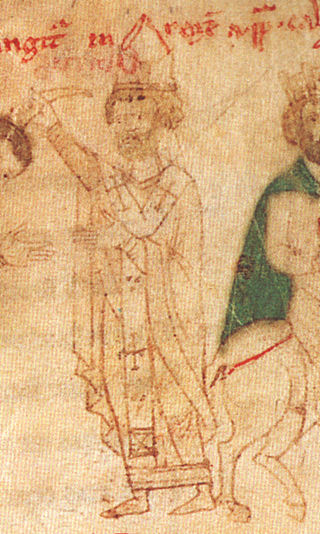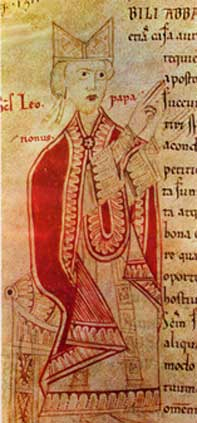The first synod of Rouen is generally believed to have been held by Archbishop Saint-Ouen about 650. Sixteen of its decrees, one against simony, the others on liturgical and canonical matters, are still extant. [1]
Later synods were presided over by:
- Archbishop St. Ansbert some time between 689 and 693
- Archbishop Mauger in 1048
- the papal legate Hermanfrid of Sitten at Lisieux in 1055, at which Archbishop Mauger of Rouen was deposed for his loose morals
- Archbishop Maurilius in 1055, which drew up a creed against Berengarius of Tours to be subscribed to by all newly elected bishops
- Archbishop John of Bayeux, one in 1072 and two in 1074, urging ecclesiastical reforms
- Archbishop William in 1096, at which the decrees of the Council of Clermont (1095) were proclaimed
- Archbishop Goisfred in 1118, at which the papal legate Conrad asked the assembled prelates and princes to support Gelasius II against Emperor Henry V and his antipope, Burdinus (Gregory VIII)
- the same Archbishop in 1119, and the cardinal legate Matthew of Albano, in 1128, to enforce clerical celibacy
- Archbishop Gualterus in 1190, and the papal legate Robert de Courçon, in 1214 to urge clerical reform.
Other synods were held in 1223, 1231, 1278, 1313, 1321, 1335, 1342, 1445, and 1581. The synod held by Archbishop Jacques-Nicolas Colbert in 1699 condemned Fénelon's Maximes des Saints.
The last provincial synod was held by Archbishop Louis-Marie-Edmont Blanquart de Bailleul in 1830; for its Acts see Collectio Lacensis, IV, 513–36.

Gil Álvarez Carrillo de Albornoz more commonly Gil de Albornoz, was a Spanish curial cardinal, archbishop of Toledo from 13 May 1338 to 17 December 1350. Grand Penitentiary from December 1352 to August 23, 1364. Cardinal priest with the title of San Clemente from December 17, 1350 to December 1356. Cardinal bishop of Sabina from December 1356 to August 23, 1364. Cardinal legate and vicar general from 30 June 1353 to 1357, who led as condottiere Papal States mercenary armies in two campaigns to reconquer territory in Italy, and statesman.
Pope Alexander II, born Anselm of Baggio, was the head of the Roman Catholic Church and ruler of the Papal States from 1061 to his death in 1073. Born in Milan, Anselm was deeply involved in the Pataria reform movement. Elected according to the terms of his predecessor's bull, In nomine Domini, Anselm's was the first election by the cardinals without the participation of the people and minor clergy of Rome. He also authorized the Norman Conquest of England in 1066.
Pope Honorius II, born Lamberto Scannabecchi, was head of the Catholic Church and ruler of the Papal States from 21 December 1124 to his death in 1130.

Pope Callixtus II or Callistus II, born Guy of Burgundy, was head of the Catholic Church and ruler of the Papal States from 1 February 1119 to his death in 1124. His pontificate was shaped by the Investiture Controversy, which he was able to settle through the Concordat of Worms in 1122.
Pope Stephen IX was the head of the Catholic Church and ruler of the Papal States from 3 August 1057 to his death in 29 March 1058. He was a member of the Ardenne-Verdun family, who ruled the Duchy of Lorraine, and started his ecclesiastical career as a canon in Liège. He was invited to Rome by Pope Leo IX, who made him chancellor in 1051 and one of three legates to Constantinople in 1054. The failure of their negotiations with Patriarch Michael I Cerularius of Constantinople and Archbishop Leo of Ohrid led to the permanent East-West Schism. He continued as chancellor to the next pope, Victor II, and was elected abbot of the Benedictine monastery of Montecassino.

The Council of Ephesus was a council of Christian bishops convened in Ephesus in AD 431 by the Roman Emperor Theodosius II. This third ecumenical council, an effort to attain consensus in the church through an assembly representing all of Christendom, confirmed the original Nicene Creed, and condemned the teachings of Nestorius, Patriarch of Constantinople, who held that the Virgin Mary may be called the Christotokos, "Christ-bearer" but not the Theotokos, "God-bearer". It met in June and July 431 at the Church of Mary in Ephesus in Anatolia.

Pope Leo IX, born Bruno von Egisheim-Dagsburg, was the head of the Catholic Church and ruler of the Papal States from 12 February 1049 to his death in 1054. Leo IX is considered to be one of the most historically significant popes of the Middle Ages; he was instrumental in the precipitation of the Great Schism of 1054, considered the turning point in which the Catholic and Eastern Orthodox Churches formally separated. He is venerated as a saint in the Catholic Church.
Pope Nicholas I, called Nicholas the Great, was the bishop of Rome and ruler of the Papal States from 24 April 858 until his death. He is remembered as a consolidator of papal authority, exerting decisive influence on the historical development of the papacy and its position among the Christian nations of Western Europe. Nicholas I asserted that the pope should have suzerainty over all Christians, even royalty, in matters of faith and morals.

The Council of Clermont was a mixed synod of ecclesiastics and laymen of the Catholic Church, called by Pope Urban II and held from 17 to 27 November 1095 at Clermont, Auvergne, at the time part of the Duchy of Aquitaine.
Pope John XV was the bishop of Rome and ruler of the Papal States from August 985 until his death. A Roman by birth, he was the first pope who canonized a saint. The origins of the investiture controversy stem from John XV's pontificate, when the dispute about the deposition of Archbishop Arnulf of Reims soured the relationship between the Capetian kings of France and the Holy See.
Pope John X was the bishop of Rome and nominal ruler of the Papal States from March 914 to his death. A candidate of the counts of Tusculum, he attempted to unify Italy under the leadership of Berengar of Friuli, and was instrumental in the defeat of the Saracens at the Battle of Garigliano. He eventually fell out with Marozia, who had him deposed, imprisoned, and finally murdered. John’s pontificate occurred during the period known as the Saeculum obscurum.
Arles in the south of Roman Gaul hosted several councils or synods referred to as Concilium Arelatense in the history of the early Christian church.
Council of Avignon may refer to one of a number of councils of the Roman Catholic Church which were held in Avignon in France. The first reported council met in the 11th century and the final council on record was in the mid-19th century.
Hugh of Die was a French Catholic bishop.
Cuno of Praeneste was a German Cardinal and papal legate, an influential diplomatic figure of the early 12th century, active in France and Germany. He held numerous synods throughout Europe, and excommunicated the Emperor Henry V numerous times, in the struggle over the issue of lay investiture of ecclesiastical offices. He spent six years promoting the acceptance of Thurstan of York as archbishop by King Henry I of England, without making York subject to Canterbury. He was seriously considered for election to the papacy in 1119, which he refused.
Reims, located in the north-east of modern France, hosted several councils or synods in the Roman Catholic Church. These councils did not universally represent the church and are not counted among the official ecumenical councils.

Mauger was born around 1019 near Dieppe. He was the younger son of Richard II, Duke of Normandy, and his second wife, Papia of Envermeu.
Maurilius was a Norman Archbishop of Rouen from 1055 to 1067.

Peter Damian, OSB was a reforming Benedictine monk and cardinal in the circle of Pope Leo IX. Dante placed him in one of the highest circles of Paradiso as a great predecessor of Francis of Assisi and he was declared a Doctor of the Church on 27 September 1828. His feast day is 21 February.
![]() This article incorporates text from a publication now in the public domain : Herbermann, Charles, ed. (1913). "Synods of Rouen". Catholic Encyclopedia . New York: Robert Appleton Company.
This article incorporates text from a publication now in the public domain : Herbermann, Charles, ed. (1913). "Synods of Rouen". Catholic Encyclopedia . New York: Robert Appleton Company.




